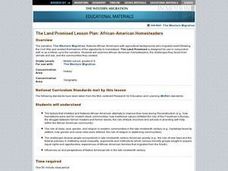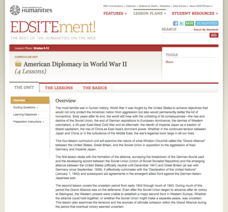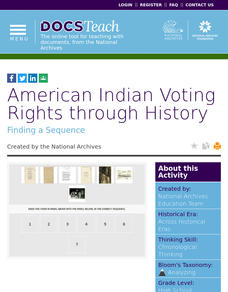Curated OER
The Land Promised: African-American Homesteaders
Students explore the story of African Americans with agricultural backgrounds who migrated west following the Civil War and availed themselves of the opportunity to homestead. They access a multi-media narrative imbedded in this plan.
Curated OER
African-American Participation in Wars and Conflicts
Students research the enlistment of African Americans, including particular divisions and individuals, in different conflicts. They access a narrative which contains excellent information they can use to research a variety of conflicts.
National Endowment for the Humanities
American Diplocmacy in World War II
The end of World War II saw the world deeply changed over the last few years. Four thorough lessons explore post-war Europe, America, and Asia through reading assignments and discussion questions about the Grand Alliance and the signing...
Crafting Freedom
Harriet Jabocs and Elizabeth Keckly: The Material and Emotional Realities of Childhood in Slavery
Learning how to make accurate inferences by putting together facts found in multiple sources is one of those skills all learners must develop, but one that can be a challenge to teach. This resource is a must-have for your curriculum...
Gilder Lehrman Institute of American History
Slave Narratives: Frederick Douglass, Harriet Jacobs, and the Columbian Orator
Young historians practice in-depth, quality analysis of primary source texts in this three-lesson unit, which examines excerpts from the slave narratives of Frederick Douglass, Harriet Jacobs, and Caleb Bingham.
Scholastic
Jackie Robinson
Learners complete a six-page coloring book featuring Major League Baseball's first African American player, Jackie Robinson. To bring the pages to life, scholars follow directions adding color and pictures where directed.
Center for History Education
Speaking Up and Speaking Out: Exploring the Lives of Black Women During the 19th Century
Young historians investigate the often-hidden history of free and enslaved African American women before the Civil War. Using a collection of primary and secondary sources, including speeches, diaries, and poems, they evaluate the often...
National WWII Museum
The Red Ball Express: Statistics as Historical Evidence
Historians use all kinds of information to make conclusions ... including statistics. Young scholars examine how two historians evaluate The Red Ball Express—a supply line staffed primarily by African Americans—using numbers. The...
CHPCS
The United States in the 1920s: The New Negro Movement and the Harlem Renaissance
Music, writing, and activism all tell the story of history! The resource uses these elements and more in a presentation to discuss the Jazz Age and Harlem Renaissance. Your class views biographies, discusses important events, and...
DocsTeach
American Indian Voting Rights through History
Vote ... it's your right! An enlightening lesson examines the history of voting rights for Native Americans. Leaners analyze primary documents and place them in chronological order. Academics also create a list of other events that took...
Curated OER
History Review: Colonial America
Explore key moments in American history with the click of a mouse! Learners read 50 questions from different eras in early America, and watch the rest of the presentation to find more questions to answer.
Curated OER
The National Women's Party and the Enfranchisement of Black Women
Students analyze the attitudes and hostility given to African-American women within the National Women's Party. They finish the lesson by examining another moment in the party's history and writing about it.
Curated OER
Harlem Renaissance
Students investigate the African American culture in the 1920's and the Harlem Renaissance. They read and analyze poems written by poets of the Harlem Renaissance, listen to jazz music and identify the characteristics of the music, and...
Curated OER
Famous African Americans Mini book
Learners discuss the achievements of famous African Americans. In this African American history month lesson, students discuss the origins of African American history month. They define prejudice and the obstacles that many African...
Curated OER
Music of Slavery and Oppression in the Mid-1800's
Students examine 19th century life for African-Americans. In this slavery lesson, students analyze the lyrics of slave songs and present their findings to their classmates.
Curated OER
Carter G. Woodson: Father of Black History Month
Young scholars explore the life and accomplishments of Carter G. Woodson, the father of black history. They read and discuss his educational pursuits and discover he was the second black man in history to receive a doctor's degree....
Curated OER
Jazz Exploration: A Collage Project
Middle schoolers explore and experience jazz through collage. They listen to improvisational jazz, discuss the origins of jazz, then design and create a collage that shows jazz being played. This project will result in amazing works of...
New York State Education Department
Global History and Geography Examination: June 2017
Learners respond to multiple choice, short answer, and essay questions to demonstrate their understanding of global history and geography.
Smithsonian Institution
The Vocal Blues: Created in the Deep South of the U.S.
Bring the sounds of the deep South vocal blues to the classroom with a Smithsonian Folkways lesson. In preparation, scholars listen to and count the 12 bar blues patterns in several works and identify the I, II, IV, and V chords as well...
Teaching Tolerance
Jim Crow as a Form of Racialized Social Control
Just because slavery was illegal doesn't mean it went away ... Jim Crow Laws took its place. An eye-opening lesson focuses on how Jim Crow Laws were used as a form of racial social control against African Americans in the United States....
Curated OER
Native American Story Necklaces
Combine a study of Native American history and art in this lesson. Learners discuss the importance of fetishes in Native American culture, the history of necklaces, and create their own works of art. Your class will find this to be both...
Curated OER
Reading Questions: Alex Haley's "My Furthest Back Person: The African"
Based on Alex Haley's moving essay "My Furthest Back Person: The African," these 11 questions support comprehension and prepare readers for discussion of the text. Use this tool, and the essay, as a nonfiction addition to units on...
Curated OER
Introduce Vocabulary: Rap a Tap Tap (Dillon)
Explore the dancing prodigy and Depression-era African-American icon Bill Robinson as scholars learn new vocabulary words in context. As you read Leo Dillon's Rap a Tap Tap they listen for six new words: clatter, greet, passion, pause,...
PBS
Hidden Messages in Spirituals
Slaves laboring in the cotton fields of the old South singing joyously may have convinced overseers that their workforce was happy and content, but in truth, these spirituals contained secret codes. After viewing a short video about...

























